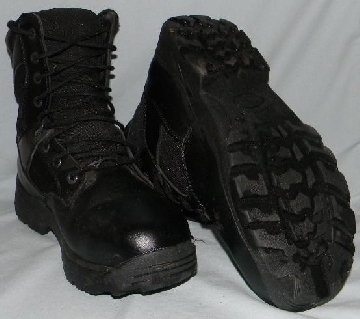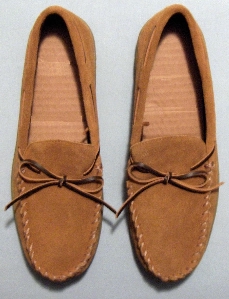
















Shoes and Boots for Hard Times
Copyright © July 1, 2011 by Robert Wayne Atkins, P.E.
All Rights Reserved.
 In the United States of America the vast majority of us have no real appreciation for our footwear. Most of us make our footwear choices based on what looks nice and what blends into our normal work and social environments. Most of our footwear choices are totally inappropriate for a long-term hard times tragedy event where we may have to walk (or bicycle) several miles every day. Therefore please allow me to make the following suggestions for selecting practical hard times survival footwear:
In the United States of America the vast majority of us have no real appreciation for our footwear. Most of us make our footwear choices based on what looks nice and what blends into our normal work and social environments. Most of our footwear choices are totally inappropriate for a long-term hard times tragedy event where we may have to walk (or bicycle) several miles every day. Therefore please allow me to make the following suggestions for selecting practical hard times survival footwear:
- Comfort: Your footwear should be very comfortable. If you could not walk five miles in your shoes or boots then those shoes or boots are not suitable for a long-term hard times tragedy event.
- Size: To prevent foot blisters you should be able to wear a thin pair of ankle high nylon footies under your existing socks. Or you should be able to wear two pair of thin socks. Therefore your shoes will probably need to be at least one-half size larger than what you have been buying in the past. The average lady will immediately reject this recommendation because in her mind the smaller the shoe size the more attractive she is. However, if on some future day her survival depends on her being able to walk twenty miles per day for two weeks then she would give anything for a comfortable pair of walking shoes. If she is with a group of people whose lives depend on reaching a specific area in a certain period of time then they will not be able to wait on her. At that time her previous vanity and her current foot blisters will be the reason she won't be able to keep up with the rest of the group and therefore she will be left behind to catch up when and if she can.
- Quality: The footwear you own at the beginning of a hard times tragedy event will probably need to last each member of your family for several years. Or you will need to purchase several replacement pair of footwear for each family member. Having several pair of shoes is a great idea if you are absolutely certain you will never need to abandon your current home. But if events should unfold in an unexpected manner and your survival demands that you abandon your home then you will have a limited amount of space in which to pack all the stuff you want to take with you. In that situation the wisdom of owning and wearing one high quality set of footwear will become obvious.
- Waterproof: Wet feet cause a multitude of foot problems. Therefore keeping your feet dry and fungus free should be a high priority. There may be times when you must travel in wet weather, or in the snow, or during the early morning hours when the dew is all over the ground vegetation. In those situations waterproof footwear is an absolute necessity.
- Slip Resistant Soles: Any footwear with smooth soles is a disaster waiting to happen. Ribbed or tread type soles will help you maintain your balance while transversing slippery areas, or areas with loose gravel, or ascending or descending a steep hill. The ability to avoid a potentially disabling accident (sprained ankle or broken leg) is critical to your long-term survival.
- Reinforced Toes: If something really heavy falls on or is dropped on the front part of your feet then your toes could get crushed. If this happens then you will be either temporarily or permanently crippled and this would significantly reduce your chances for long-term survival. Therefore either a steel toe or a reinforced toe is highly desirable in footwear. However, the vast majority of the reinforced toe footwear that is available is extremely uncomfortable to wear. The reinforced toe area rubs against your toes and blisters soon appear. Therefore before you invest in this type of footwear you should try the footwear on while wearing two thin pair of socks and see if the entire shoe and especially the toe area feels really comfortable. In other words, never purchase footwear over the internet or out of a catalog.
- Air Cushion Inserts or Soles: You should probably avoid shoes or boots that have "air cushion inserts or soles." I have owned several pair of these "air" shoes in the past and most of them worked fine until they eventually wore out and had to be replaced. But I have had the occasional "air" shoe gradually develop a tiny invisible "leak" and the shoe would squeak whenever I would start walking. You don't need "squeaking" shoes or boots to draw attention to yourself if you are trying to blend in and not be noticed.
- Application or Purpose: Another consideration is how you will normally be using your shoes or boots:
- Work Boots: You will need heavy-duty boots that meet all the above requirements.
- Walking Shoes: If you anticipate long distance hikes or walks then the total weight of your footwear becomes a critical issue. In order to minimize fatigue you may wish to purchase shoes that are specifically designed for walking. These shoes should have slip resistant soles and they should allow your feet to breathe. You probably will not require reinforced toes because they add additional weight to the shoe and this is a disadvantage is you are just walking from one location to the next location.
- Bicycle Shoes: To pedal a bicycle you will be raising and lowering your legs continuously. That means you will be raising and lowering whatever you are wearing on your feet. In this situation you should try to minimize the total weight of your footwear. However, a critical issue for bicycle shoes is that they have excellent ribbed or tread types soles that will make positive contact with the bicycle pedals without slipping. A good pair of walking shoes could be used as bicycle shoes if they have the proper type of soles.
- Color: Either brown or black are preferred for a hard times event. Either of these two colors will match your other clothing and they will not attract any unusual attention in a populated area and either color will also help you to quickly and easily blend into a wilderness environment.
- Cleaning and Drying: When your footwear occasionally gets wet you should wipe the moisture off your footwear with an old rag or dry cloth. Do not dry your footwear using heat, such as placing your wet footwear near a fireplace. The heat will not only dry off the moisture but it will also deplete the natural oils in the shoe leather and this will significantly reduce the useful life of your footwear. You should occasionally polish your footwear with a good quality shoe polish because the shoe polish will replenish some of the natural oils in the leather. If you need to clean your footwear then you should use saddle soap because it is specifically designed to clean leather.
 If the hard times tragedy event lasts longer than you expected then your footwear will eventually wear out or it will need repairs. If the repair is a relatively simple one then you could fix your footwear if you had the proper repair items. One of the most common repairs is reattaching a loose sole. This can be accomplished using "Shoe Goo" that is sold in the footwear section of most Walmarts near the shoelaces and shoe polish.
If the hard times tragedy event lasts longer than you expected then your footwear will eventually wear out or it will need repairs. If the repair is a relatively simple one then you could fix your footwear if you had the proper repair items. One of the most common repairs is reattaching a loose sole. This can be accomplished using "Shoe Goo" that is sold in the footwear section of most Walmarts near the shoelaces and shoe polish.
However, regardless of the quality of your footwear they will eventually wear out with the passage of time. When that happens you will have three basic options for replacing your footwear as follows:
- Cobbler Trade: You could learn the cobbler trade and then make your own shoes and boots. Over the years I have studied this skill area several times and each time I decided that it was not the type of skill I really needed to learn. However, you may decide otherwise. If there were any good cobbler books on "How to Make Your Own Shoes and Boots" that were still in print then I would recommend one of them here. Unfortunately this is not a trade that has good reference materials for the home craftsman.
- Tire Sandals: You could make tire sandals. Detailed instructions for making tire sandals are at the following web site: http://www.hollowtop.com/sandals.htm
- Moccasins: You could make moccasins using cowhide or buckskins. One web site that describes how to make moccasins is: http://jumaka.com/moccasins/MakingMoccasins/MoccasinInstructions.htm
A unique easy way to make moccasins is also described in detail in my book "How to Tan Animal Hides and How to Make High Quality Buckskin Clothing."
Respectfully,
Grandpappy.
Grandpappy's e-mail address is: RobertWayneAtkins@hotmail.com




































 In the United States of America the vast majority of us have no real appreciation for our footwear. Most of us make our footwear choices based on what looks nice and what blends into our normal work and social environments. Most of our footwear choices are totally inappropriate for a long-term hard times tragedy event where we may have to walk (or bicycle) several miles every day. Therefore please allow me to make the following suggestions for selecting practical hard times survival footwear:
In the United States of America the vast majority of us have no real appreciation for our footwear. Most of us make our footwear choices based on what looks nice and what blends into our normal work and social environments. Most of our footwear choices are totally inappropriate for a long-term hard times tragedy event where we may have to walk (or bicycle) several miles every day. Therefore please allow me to make the following suggestions for selecting practical hard times survival footwear: If the hard times tragedy event lasts longer than you expected then your footwear will eventually wear out or it will need repairs. If the repair is a relatively simple one then you could fix your footwear if you had the proper repair items. One of the most common repairs is reattaching a loose sole. This can be accomplished using "Shoe Goo" that is sold in the footwear section of most Walmarts near the shoelaces and shoe polish.
If the hard times tragedy event lasts longer than you expected then your footwear will eventually wear out or it will need repairs. If the repair is a relatively simple one then you could fix your footwear if you had the proper repair items. One of the most common repairs is reattaching a loose sole. This can be accomplished using "Shoe Goo" that is sold in the footwear section of most Walmarts near the shoelaces and shoe polish.
